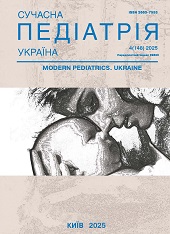Diagnostics and treatment of the structural forms of epilepsy combined with anomalies of brain development in early children age
DOI:
https://doi.org/10.15574/SP.2025.4(148).177181Keywords:
children, structural epilepsy, Arnold-Chiari syndromeAbstract
It is known that structural epilepsy occurs frequently at children’s age. Moreover, structural epilepsies are formed in some cases because of the pathological influence of congenital brain anomalies.
Aim - using the clinical case to present the features of the starts of structural epilepsy based on congenital brain anomalies in early age children and approach treatment for them.
The presented clinical case in the article showed the first focal epileptic seizures appeared at the age of 3.5 years old in the patient with Arnold-Chiari syndrome. Valproic acid has been prescribed as the first medication. The combined therapy included lamotrigine and diacarb has been prescribed for the incomplete control treatment the epileptic seizures in the patient. The next examination we carried out in 14 patients early children age with structural epilepsy caused congenital brain anomalies. Frequent predominately focal epileptic seizures started during the first fourth years of life have been found in the patients. The prescribed combined anticonvulsant therapy was effective in the patients.
Conclusions. Congenital brain anomalies as a cause of structural epilepsy in form predominately of focal epileptic seizures appeared in early children age. The prescribed therapy of epilepsy depended on the forms of them and children’s age. The next use of genetic investigation is important for confirming a possible genetic anomaly.
The study was conducted in accordance with the principles of the Declaration of Helsinki. The study protocol was approved by the Local Ethics Committee for all participants. Informed consent was obtained from parents of child.
No conflict of interest was declared by the authors.
References
Brigo F, Zelano J, Abraira L et al. (2024, Jan). Taking a fresh look at structural epilepsies and acute symptomatic seizures. Epilepsy and Behavior. 150: 109591. https://doi.org/10.1016/j.yebeh.2023.109591; PMid:38128314
Dilena R, Molisso MT, De Carli A et al. (2024, Oct). Retrospective study on neonatal seizures in a tertiary center of northern Italy after ILAE classification: Incidence, seizure type, EEG and etiology. Epilepsy and Behavior. 159: 109971. https://doi.org/10.1016/j.yebeh.2024.109971; PMid:39094245
Evtushenko S, Evtushenko O, Suhonosova O. (2016). Neurology of early children's age. Kiev: Zaslavsky O.: 288.
Kim S, Oh S-J, Kong S-K, Choi S-W. (2024). A Case of Type 1 Arnold-Chiari Malformation with Isolated Dizziness. J Clin Otolaryngol Head Neck Surg. 35(3): 105-108. https://doi.org/10.35420/jcohns.2024.35.3.105
Klein P, Friedman D, Kwan P. (2024, Dec). Recent Advances in Pharmacologic Treatments of Drug - Resistant Epilepsy: Breakthrough in Sight. CNS Drugs. 38(12): 949-960. https://doi.org/10.1007/s40263-024-01130-y; PMid:39433725
Kohutkova M, Horn F. (2024). Arnold-Chiari Malformations in Pediatric Patients After Fetal Surgery for Meningomyelocele. J. Clin. Med. 13(22): 6721. https://doi.org/10.3390/jcm13226721; PMid:39597865 PMCid:PMC11595094
Ktrakyan LA, Havryliv TS, Smolanka VI et al. (2021). Cerebrospinal fluid flow impairment in the patients with Chiari malformation: predictors of syringomyelia cysts development and dynamics of postoperative regression. International neurological journal. 17(6): 27-36. https://doi.org/10.22141/2224-0713.17.6.2021.242233
Martyniuk VYu, Znamenska TK, Shveikina VB et al. (2021). Modern approach to diagnosis and treatment of seizures in newborns and early age children. Modern Pediatrics. Ukraine. 4(116): 56-75. https://doi.org/10.15574/SP.2021.116.56
Rodriguez-Blanque R, Almazan-Soto C, Piqueras-Sola B, Carlos Sanchez-Garcia J et al. (2023). Chiari Syndrome: Advances Epidemiology and Pathogenesis: A Systematic Review. J. Clin. Med. 12(20): 6694. https://doi.org/10.3390/jcm12206694; PMid:37892831 PMCid:PMC10607306
Tarasova EO, Tereshchenko LA, Garifulina AR et al. (2023). Arnold-Chiari anomaly: what to pay attention. 3(155): 1-3. doi: 10.32471umj.1680-3051.155.242081.
Trishchynskaya MA, Svystilnyk VO. (2019). The neurological symptoms clinical diagnostics role in patients with genetic diseases. Modern medical technology. 2: 69-73. https://doi.org/10.34287/MMT.2(41).2019.44
Downloads
Published
Issue
Section
License
Copyright (c) 2025 Modern pediatrics. Ukraine

This work is licensed under a Creative Commons Attribution-NonCommercial 4.0 International License.
The policy of the Journal “MODERN PEDIATRICS. UKRAINE” is compatible with the vast majority of funders' of open access and self-archiving policies. The journal provides immediate open access route being convinced that everyone – not only scientists - can benefit from research results, and publishes articles exclusively under open access distribution, with a Creative Commons Attribution-Noncommercial 4.0 international license (СС BY-NC).
Authors transfer the copyright to the Journal “MODERN PEDIATRICS. UKRAINE” when the manuscript is accepted for publication. Authors declare that this manuscript has not been published nor is under simultaneous consideration for publication elsewhere. After publication, the articles become freely available on-line to the public.
Readers have the right to use, distribute, and reproduce articles in any medium, provided the articles and the journal are properly cited.
The use of published materials for commercial purposes is strongly prohibited.

